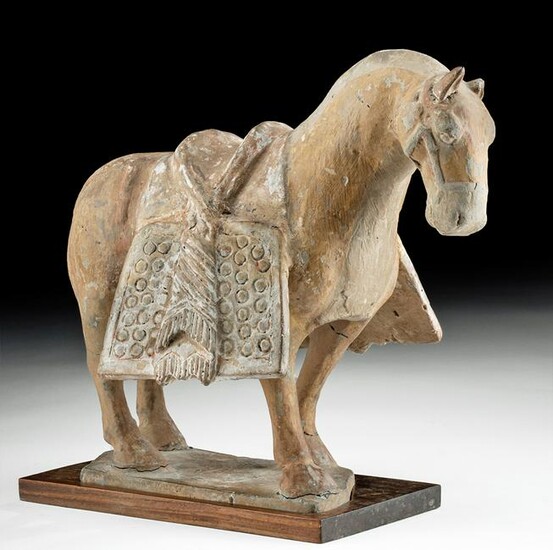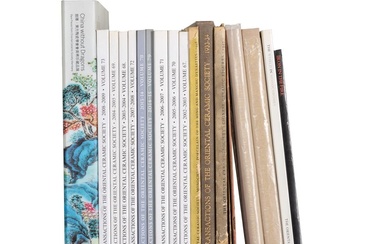Chinese Tang Dynasty Polychrome Horse w/ TL
East Asia, China, Tang Dynasty, ca. 618 to 906 CE. A lovely mold-made pottery horse shown in stride atop an integral plinth. Painted in hues of apricot, peach, and chocolate brown, the noble steed displays a naturalistic head with a bulbous snout, incised nostrils, and almond-shaped eyes, all capped by a pair of perky ears. His thick body bears an elaborate saddle featuring lengthy polka-dot-incised saddle flaps beneath a striped sash. A slender tapered tail extends downwards from the ancient horse's posterior and an ovoid vent is featured on the animal's underside. Size: 8.75" L x 5" W x 7.5" H (22.2 cm x 12.7 cm x 19 cm); 7.75" H (19.7 cm) on included custom stand.
According to Zhixin Jason Sun, Curator of the Department of Asian Art at the Metropolitan Museum of Art, "The importance of horses rose to new heights in the Tang dynasty (618–907) when, as emblems of imperial power, they marched in state processions, galloped through royal hunting parks, raced across polo fields, and even danced before the emperor. Their portraits were painted by leading court artists, and their majestic form was modeled in brightly glazed pottery as tomb figurines and sculpted on marble plaques to adorn emperors' tombs as symbols of dynastic vitality." Beyond this, the horse played a significant role in the unification of the Chinese Empire, as the ancients could communicate to parties near and far due to the great speed of these noble steeds. The horse also assisted the military to conquer distant lands and grow the empire. As the desire for stronger, faster breeds grew, the ancients imported horses from Central Asia, leading to the creation of the famous Silk Road.
We see evidence of the reverence for the horse in the visual culture of ancient China. Imagery of horses abound in painting, literature, and sculpture. During the Tang dynasty, artists created burial art representing these revered animals. This particular piece depicts a large charger; this type of horse served as both a symbol of imperial stability that engendered bountiful trade and prosperity for the expanding empire and the reward of military exploits to the west. The most cherished horses were raised in the western kingdom of Ferghana and known as "blood-sweating horses." These were delivered as tribute to the reigning emperor. In general, for the ancient Chinese, horses were a sign of wealth.
This piece has been tested using thermoluminescence (TL) analysis and has been found to be ancient and of the period stated. A full report will accompany purchase.
Provenance: private Reno, Nevada, USA collection, acquired through descent, originally purchased in San Francisco, California, USA in the 1960s to 1970s
All items legal to buy/sell under U.S. Statute covering cultural patrimony Code 2600, CHAPTER 14, and are guaranteed to be as described or your money back.
A Certificate of Authenticity will accompany all winning bids.
We ship worldwide to most countries and handle all shipping in-house for your convenience.
#163709
Condition Report: TL holes on bottom of saddle, under lower jaw, and between front legs. Repaired from several pieces with restoration to front of base and restoration over break lines. Break line visible on proper right ear. Chip to proper left ear. Expected surface wear with nick, abrasions, and some chipping to paint as shown, all commensurate with age. Otherwise, very good with nice remaining pigments
View it on
Sale price
Estimate
Time, Location
Auction House
East Asia, China, Tang Dynasty, ca. 618 to 906 CE. A lovely mold-made pottery horse shown in stride atop an integral plinth. Painted in hues of apricot, peach, and chocolate brown, the noble steed displays a naturalistic head with a bulbous snout, incised nostrils, and almond-shaped eyes, all capped by a pair of perky ears. His thick body bears an elaborate saddle featuring lengthy polka-dot-incised saddle flaps beneath a striped sash. A slender tapered tail extends downwards from the ancient horse's posterior and an ovoid vent is featured on the animal's underside. Size: 8.75" L x 5" W x 7.5" H (22.2 cm x 12.7 cm x 19 cm); 7.75" H (19.7 cm) on included custom stand.
According to Zhixin Jason Sun, Curator of the Department of Asian Art at the Metropolitan Museum of Art, "The importance of horses rose to new heights in the Tang dynasty (618–907) when, as emblems of imperial power, they marched in state processions, galloped through royal hunting parks, raced across polo fields, and even danced before the emperor. Their portraits were painted by leading court artists, and their majestic form was modeled in brightly glazed pottery as tomb figurines and sculpted on marble plaques to adorn emperors' tombs as symbols of dynastic vitality." Beyond this, the horse played a significant role in the unification of the Chinese Empire, as the ancients could communicate to parties near and far due to the great speed of these noble steeds. The horse also assisted the military to conquer distant lands and grow the empire. As the desire for stronger, faster breeds grew, the ancients imported horses from Central Asia, leading to the creation of the famous Silk Road.
We see evidence of the reverence for the horse in the visual culture of ancient China. Imagery of horses abound in painting, literature, and sculpture. During the Tang dynasty, artists created burial art representing these revered animals. This particular piece depicts a large charger; this type of horse served as both a symbol of imperial stability that engendered bountiful trade and prosperity for the expanding empire and the reward of military exploits to the west. The most cherished horses were raised in the western kingdom of Ferghana and known as "blood-sweating horses." These were delivered as tribute to the reigning emperor. In general, for the ancient Chinese, horses were a sign of wealth.
This piece has been tested using thermoluminescence (TL) analysis and has been found to be ancient and of the period stated. A full report will accompany purchase.
Provenance: private Reno, Nevada, USA collection, acquired through descent, originally purchased in San Francisco, California, USA in the 1960s to 1970s
All items legal to buy/sell under U.S. Statute covering cultural patrimony Code 2600, CHAPTER 14, and are guaranteed to be as described or your money back.
A Certificate of Authenticity will accompany all winning bids.
We ship worldwide to most countries and handle all shipping in-house for your convenience.
#163709
Condition Report: TL holes on bottom of saddle, under lower jaw, and between front legs. Repaired from several pieces with restoration to front of base and restoration over break lines. Break line visible on proper right ear. Chip to proper left ear. Expected surface wear with nick, abrasions, and some chipping to paint as shown, all commensurate with age. Otherwise, very good with nice remaining pigments







